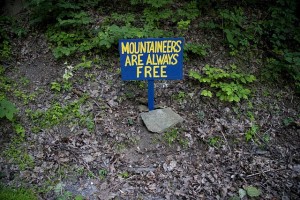
“The corporations take advantage of people in Appalachia, and this is happening all over Appalachia, not just West Virginia… We have to save one mountain at a time.”
-Psera Newman, Lexington KY
Billy Bragg sings about there being power in a union. But after the past week, I see that there is power not just in unions, but in unity.
Over the past week, some amazing friends of mine organized one of the largest anti-mountaintop removal actions in the history of Appalachia. The March on Blair Mountain brought together a march and mobile convergence that not only brought out Appalachian community residents, students, and environmentalists that have been fighting mountaintop removal for the past few years, but also built alliances with rank and file labor.
Coal companies are not only seeking to “remove” Blair Mountain’s pristine forests, destroy it’s wildlife and poison the neighboring communities, but they are also seeking to “remove” the actual history of the place. In 1921, 7,000-10,000 miners organizing southern West Virginia’s coal mines had a five-day battle with coal thugs, private security forces and federal troops on the top of Blair Mountain. The corporations literally had airplanes drop surplus World War One bombs on the union miners.
On Saturday, Robert F. Kennedy Jr., speaking at the rally, aptly described the Battle of Blair Mountain as “labor’s Gettysburg.” It was a turning point for the legitimization of labor unions in this country. You can see why Corporate America wants to erase it from the history books.
Arch Coal and Alpha Natural Resources (which includes recently acquired Massey Energy operations) have had Blair Mountain’s historical preservation status revoked, have started mining operations on the mountain and are seeking further permitting for strip mining. Alpha is trying to put a kinder, gentler face on coal mining, both underground and on the mountaintops. Their response to the March on Blair Mountain was to put out a statement saying they had no intention of blasting the battleground. But do we really trust one of the many corporations that have contributed to the destruction of 500 Appalachian mountains, poisoned it’s waters and waged war on it’s population?

Last week, a multi-generational, multi-racial, multi-issue group of over 200 marched 50 miles from Marmet, WV to Blair Mountain, WV to commemorate the 90th anniversary of the Battle of Blair Mountain and call for an end to mountaintop removal. I had friends that joined the march from Texas, Utah, Wyoming, Chicago, Australia and all up and down the East Coast and the Mid-West.
It wasn’t without it’s challenges. The coal companies used intimidation tactics to have six six campsite reservations canceled during the week and a half-long march. And through much of the march, counter-protesters screamed obscenities and shot the finger at marchers. But despite these hardships, they reached the foot of Blair Mountain for a 1,000-person rally and march to the top of Blair Mountain.
The other highlight of the March on Blair Mountain was the direct action. Organizers and participants felt it important that something happen on the actual battlefield itself. The battlefield is now company property and the entrance was protected by private security, locked gates and state police. An action on the battlefield meant a trespass on company property.
While much of the march was organized using “leadership models,” the action planning quickly turned to horizontal organizing. Much like the anti-nuclear movement and the global justice movement, planning used affinity groups and an impromptu spokescouncil meeting to sort out details and make decisions about what the action would do and look like. More than ten affinity groups formed to anchor a breakaway march that went to commemorate the history of Blair Mountain. Some 150 people went onto the battlefield site to set up memorials.
They were eventually evicted by state police and one person was arrested.











